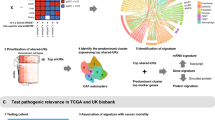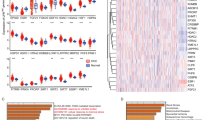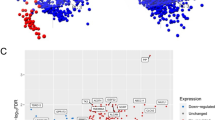Abstract
Purpose
Despite advances in the development of treatments for laryngeal cancer (LC), including surgical treatments and radio-chemotherapy, the survival rate of LC remains low. Therefore, novel metabolic signatures are urgently needed to evaluate the prognosis of LC patients.
Methods
Differentially expressed metabolic genes were extracted via bioinformatics analysis from the raw data of The Cancer Genome Atlas and Gene Expression Omnibus (GEO) databases. Univariate Cox regression and LASSO analyses were performed to identify metabolic genes that were significantly correlated with overall survival (OS). Using the Kaplan–Meier analysis and receiver operating characteristics, the prognostic power of candidate signatures was evaluated in the two databases. Gene Set Enrichment Analysis (GSEA) was performed to explore significant signaling pathways and underlying mechanisms in the high- and low-risk groups.
Results
Thirteen metabolism genes showed superior ability to predict OS for LC when compared to clinical variables, and patients in the high-risk group showed significantly poorer OS than those in the low-risk group. The area under the curve of receiver operating curves for 5- and 3-year OS was 0.929 and 0.899, respectively, which were better than the OS obtained with clinicopathological variables. Similar results obtained in the GEO cohort indicated that this gene signature could differentiate between LC patients with and without recurrence.
Conclusion
To our knowledge, this study is the first to report that the 13 metabolic genes could serve as an independent biomarker for LC, which could provide vital prognostic information and prediction for personalized treatment of LC.





Similar content being viewed by others
References
Siegel RL, Miller KD, Jemal A (2016) Cancer statistics, 2016. CA Cancer J Clin 66(1):7–30. https://doi.org/10.3322/caac.21332
Hoffman HT, Porter K, Karnell LH, Cooper JS, Weber RS, Langer CJ, Ang KK, Gay G, Stewart A, Robinson RA (2006) Laryngeal cancer in the United States: changes in demographics, patterns of care, and survival. Laryngoscope 116(9):1–13. https://doi.org/10.1097/01.mlg.0000236095.97947.26
Hernandez BY, Goodman MT, Lynch CF, Cozen W, Unger ER, Steinau M, Thompson T, Saber MS, Altekruse SF, Lyu C, Saraiya M (2014) Human papillomavirus prevalence in invasive laryngeal cancer in the United States. PLoS ONE 9(12):e115931. https://doi.org/10.1371/journal.pone.0115931
Obid R, Redlich M, Tomeh C (2019) The treatment of laryngeal cancer. Oral Maxillofac Surg Clin N Am 31(1):1–11. https://doi.org/10.1016/j.coms.2018.09.001
Mourad M, Dezube A, Moshier E, Shin E (2016) Geographic trends in management of early-stage laryngeal cancer. Laryngoscope 126(4):880–884. https://doi.org/10.1002/lary.25768
Lin CC, Fedewa SA, Prickett KK, Higgins KA, Chen AY (2016) Comparative effectiveness of surgical and nonsurgical therapy for advanced laryngeal cancer. Cancer 122(18):2845–2856. https://doi.org/10.1002/cncr.30122
Megwalu UC, Sikora AG (2014) Survival outcomes in advanced laryngeal cancer. JAMA Otolaryngol Head Neck Surg 140(9):855–860. https://doi.org/10.1001/jamaoto.2014.1671
Kostrzewska-Poczekaj M, Byzia E, Soloch N, Jarmuz-Szymczak M, Janiszewska J, Kowal E, Paczkowska J, Kiwerska K, Wierzbicka M, Bartochowska A, Ustaszewski A, Greczka G, Grenman R, Szyfter K, Giefing M (2019) DIAPH2 alterations increase cellular motility and may contribute to the metastatic potential of laryngeal squamous cell carcinoma. Carcinogenesis 40(10):1251–1259. https://doi.org/10.1093/carcin/bgz035
Zhang G, Fan E, Zhong Q, Feng G, Shuai Y, Wu M, Chen Q, Gou X (2019) Identification and potential mechanisms of a 4-lncRNA signature that predicts prognosis in patients with laryngeal cancer. Hum Genom 13(1):36. https://doi.org/10.1186/s40246-019-0230-6
Ricciardiello F, Capasso R, Kawasaki H, Abate T, Oliva F, Lombardi A, Misso G, Ingrosso D, Leone CA, Iengo M, Caraglia M (2017) A miRNA signature suggestive of nodal metastases from laryngeal carcinoma. Acta Otorhinolaryngol Ital 37(6):467–474. https://doi.org/10.14639/0392-100x-851
Tang Z, Wei G, Zhang L, Xu Z (2019) Signature microRNAs and long noncoding RNAs in laryngeal cancer recurrence identified using a competing endogenous RNA network. Mol Med Rep 19(6):4806–4818. https://doi.org/10.3892/mmr.2019.10143
Sabari BR, Zhang D, Allis CD, Zhao Y (2017) Metabolic regulation of gene expression through histone acylations. Nat Rev Mol Cell Biol 18(2):90–101. https://doi.org/10.1038/nrm.2016.140
Wu F, Zhao Z, Chai RC, Liu YQ, Li GZ, Jiang HY, Jiang T (2019) Prognostic power of a lipid metabolism gene panel for diffuse gliomas. J Cell Mol Med 23(11):7741–7748. https://doi.org/10.1111/jcmm.14647
Cui K, Liu C, Li X, Zhang Q, Li Y (2020) Comprehensive characterization of the rRNA metabolism-related genes in human cancer. Oncogene 39(4):786–800. https://doi.org/10.1038/s41388-019-1026-9
Gökmen-Polar Y, Neelamraju Y, Goswami CP, Gu Y, Gu X, Nallamothu G, Vieth E, Janga SC, Ryan M, Badve SS (2019) Splicing factor ESRP1 controls ER-positive breast cancer by altering metabolic pathways. EMBO Rep. https://doi.org/10.15252/embr.201846078
Hu Q, Peng J, Chen X, Li H, Song M, Cheng B, Wu T (2019) Obesity and genes related to lipid metabolism predict poor survival in oral squamous cell carcinoma. Oral Oncol 89:14–22. https://doi.org/10.1016/j.oraloncology.2018.12.006
Ma B, Jiang H, Wen D, Hu J, Han L, Liu W, Xu W, Shi X, Wei W, Liao T, Wang Y, Lu Z, Wang Y, Ji Q (2019) Transcriptome analyses identify a metabolic gene signature indicative of dedifferentiation of papillary thyroid cancer. J Clin Endocrinol Metab 104(9):3713–3725. https://doi.org/10.1210/jc.2018-02686
Liang JQ, Teoh N, Xu L, Pok S, Li X, Chu ESH, Chiu J, Dong L, Arfianti E, Haigh WG, Yeh MM, Ioannou GN, Sung JJY, Farrell G, Yu J (2018) Dietary cholesterol promotes steatohepatitis related hepatocellular carcinoma through dysregulated metabolism and calcium signaling. Nat Commun 9(1):4490. https://doi.org/10.1038/s41467-018-06931-6
Jin GZ, Zhang Y, Cong WM, Wu X, Wang X, Wu S, Wang S, Zhou W, Yuan S, Gao H, Yu G, Yang W (2018) Phosphoglucomutase 1 inhibits hepatocellular carcinoma progression by regulating glucose trafficking. PLoS Biol 16(10):e2006483. https://doi.org/10.1371/journal.pbio.2006483
Smith JD, Birkeland AC, Rosko AJ, Hoesli RC, Foltin SK, Swiecicki P, Mierzwa M, Chinn SB, Shuman AG, Malloy KM, Casper KA, McLean SA, Wolf GT, Bradford CR, Prince ME, Brenner JC, Spector ME (2019) Mutational profiles of persistent/recurrent laryngeal squamous cell carcinoma. Head Neck 41(2):423–428. https://doi.org/10.1002/hed.25444
Huang SP, Chan YC, Huang SY, Lin YF (2019) Overexpression of PSAT1 gene is a favorable prognostic marker in lower-grade gliomas and predicts a favorable outcome in patients with IDH1 mutations and chromosome 1p19q codeletion. Cancers (Basel). https://doi.org/10.3390/cancers12010013
Sato K, Masuda T, Hu Q, Tobo T, Kidogami S, Ogawa Y, Saito T, Nambara S, Komatsu H, Hirata H, Sakimura S, Uchi R, Hayashi N, Iguchi T, Eguchi H, Ito S, Nakagawa T, Mimori K (2017) Phosphoserine phosphatase is a novel prognostic biomarker on chromosome 7 in colorectal cancer. Anticancer Res 37(5):2365–2371. https://doi.org/10.21873/anticanres.11574
Gong S, Xu M, Zhang Y, Shan Y, Zhang H (2020) The prognostic signature and potential target genes of six long non-coding RNA in laryngeal squamous cell carcinoma. Front Genet 11:413. https://doi.org/10.3389/fgene.2020.00413
Liu MS, Zhao H, Xu CX, Xie PB, Wang W, Yang YY, Lee WH, Jin Y, Zhou HQ (2020) Clinical significance of EPHX2 deregulation in prostate cancer. Asian J Androl. https://doi.org/10.4103/aja.aja_34_20
Zhang Z, Shi Q, Sturgis EM, Spitz MR, Wei Q (2005) Polymorphisms and haplotypes of serine hydroxymethyltransferase and risk of squamous cell carcinoma of the head and neck: a case-control analysis. Pharmacogenet Genom 15(8):557–564. https://doi.org/10.1097/01.fpc.0000170915.19522.b2
Liu S, Zhao Y, Xu Y, Sang M, Zhao R, Gu L, Shan B (2020) The clinical significance of methylation of MAGE-A1 and-A3 promoters and expression of DNA methyltransferase in patients with laryngeal squamous cell carcinoma. Am J Otolaryngol 41(1):102318. https://doi.org/10.1016/j.amjoto.2019.102318
Chien MH, Yang JS, Chu YH, Lin CH, Wei LH, Yang SF, Lin CW (2012) Impacts of CA9 gene polymorphisms and environmental factors on oral-cancer susceptibility and clinicopathologic characteristics in Taiwan. PLoS ONE 7(12):e51051. https://doi.org/10.1371/journal.pone.0051051
Rosner G, Gluck N, Carmi S, Bercovich D, Fliss-Issakov N, Ben-Yehoyada M, Aharon-Caspi S, Kellerman E, Strul H, Shibolet O, Kariv R (2018) POLD1 and POLE gene mutations in jewish cohorts of early-onset colorectal cancer and of multiple colorectal adenomas. Dis Colon Rectum 61(9):1073–1079. https://doi.org/10.1097/dcr.0000000000001150
Zhang L, Yang W, Zhu X, Wei C (2016) p53 inhibits the expression of p125 and the methylation of POLD1 gene promoter by downregulating the Sp1-induced DNMT1 activities in breast cancer. Onco Targets Ther 9:1351–1360. https://doi.org/10.2147/ott.S98713
Weiss A, Chavez-MacGregor M, Lichtensztajn DY, Yi M, Tadros A, Hortobagyi GN, Giordano SH, Hunt KK, Mittendorf EA (2018) Validation Study of the American Joint Committee on Cancer eighth edition prognostic stage compared with the anatomic stage in breast cancer. JAMA Oncol 4(2):203–209. https://doi.org/10.1001/jamaoncol.2017.4298
Auclin E, Zaanan A, Vernerey D, Douard R, Gallois C, Laurent-Puig P, Bonnetain F, Taieb J (2017) Subgroups and prognostication in stage III colon cancer: future perspectives for adjuvant therapy. Ann Oncol 28(5):958–968. https://doi.org/10.1093/annonc/mdx030
Succo G, Crosetti E, Bertolin A, Piazza C, Molteni G, Cirillo S, Petracchini M, Tascone M, Sprio AE, Berta GN, Peretti G, Presutti L, Rizzotto G (2018) Treatment for T3 to T4a laryngeal cancer by open partial horizontal laryngectomies: prognostic impact of different pathologic tumor subcategories. Head Neck 40(9):1897–1908. https://doi.org/10.1002/hed.25176
Pan Y, Hong Y, Liang Z, Zhuang W (2019) Survival analysis of distant metastasis of laryngeal carcinoma: analysis based on SEER database. Eur Arch Otorhinolaryngol 276(1):193–201. https://doi.org/10.1007/s00405-018-5244-5
Acknowledgements
The authors thank the efforts of the National Cancer Institute in the creation of the TCGA and GEO databases.
Funding
No financial assistance was required for this study.
Author information
Authors and Affiliations
Contributions
WFL and ZQW conceived and designed the study; HF and NB collected the data. MF and KZ analyzed the data. WFL and MF contributed to the writing of the manuscript.
Corresponding author
Ethics declarations
Conflict of interest
All authors indicated no potential conflicts of interest.
Data availability statement
The data used to support the findings of this study are included within the article.
Additional information
Publisher's Note
Springer Nature remains neutral with regard to jurisdictional claims in published maps and institutional affiliations.
Rights and permissions
About this article
Cite this article
Li, W., Fu, M., Zhao, K. et al. Development and validation of a novel metabolic signature for predicting prognosis in patients with laryngeal cancer. Eur Arch Otorhinolaryngol 278, 1129–1138 (2021). https://doi.org/10.1007/s00405-020-06444-3
Received:
Accepted:
Published:
Issue Date:
DOI: https://doi.org/10.1007/s00405-020-06444-3




